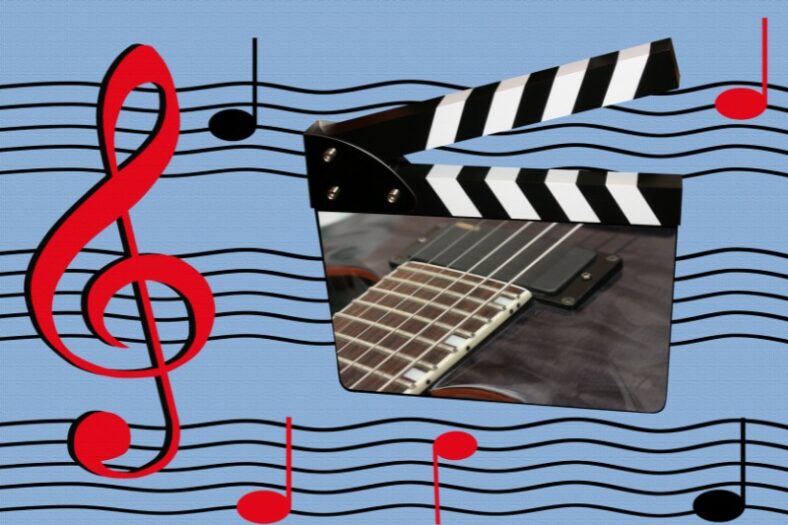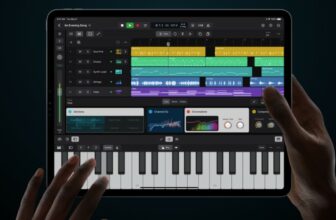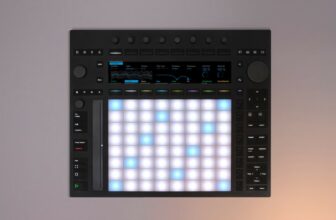How To Compose Cinematic Music (7 Tips)

Cinematic music refers not only to the music used in film and TV but also to the music that sounds like it could be used in film and TV. It’s hard to define, but broadly recognizable for its epicness, eeriness, or background-music vibe. Generally, it features orchestral instruments and no lyrics.
In other words, cinematic music is all the music that evokes a visual feeling in its listeners, as if it could be part of a movie soundtrack—regardless of the genre. But how does one compose cinematic music? And is there any way of making a pre-existing track sound more cinematic?
In the following paragraphs, I will share a few tips on how to create and add that special cinematic feel to your compositions.
Contents
1. Find a Motif
Most music revolves around a motif, which is a short musical phrase that can be easily recognizable. The guitar riff in “Eye Of The Tiger,” for example, is a textbook motif. But in cinematic music, the motif takes on even greater importance.
When you think of some of the greatest soundtracks of all time, it’s their motifs that first come to mind. There’s something about the “Harry Potter” soundtrack that sounds undoubtedly like… Harry Potter! And the same goes for the soundtracks of other popular franchises, from “Indiana Jones” to “Lord of the Rings.”
This happens because experienced film composers know the importance of relying on a solid motif. It’s nothing but a simple set of notes, but it can be very useful to shape the sound of a cinematic composition.
It’s not easy to capture the essence of something (like, say, the semi-fictional universe of “Harry Potter”), but that’s what motifs are ultimately for! If you’re making cinematic music about the desert, for example, start by finding that basic succession of four or five notes that sound like the desert, and the rest will come naturally.
2. Settle On a Vibe
One of the most distinguishing aspects of cinematic music is that it has a vibe. When I start listening to a cinematic composition, I expect to be “in the same place” from start to finish. This doesn’t mean that the composition needs to be boring, uninvolving, or repetitive. It merely means that cinematic music should take its listeners on a concise journey from start to finish.
That’s why progressive rock, with its abrupt scale and tempo modulations, doesn’t make for quality cinematic music. The same goes for songs that change drastically after a certain point, like a dubstep banger with a huge bass drop (even though dubstep songs are regularly used in film and TV soundtracks now).
Okay, so it’s important to settle on a vibe before starting a cinematic composition. But how does one go from wanting a happy/sad/scary song to making a happy/sad/scary song? Here are a few examples:
Explore the Major and Minor scales for evoking feelings of happiness and sadness
To make cinematic music with a happy vibe, use the notes in the Major scale. You’ll get that smiley, “everything’s going to be alright” vibe in a minute.
To make sad cinematic music, using the Minor scale is the answer. It’s perfect for illustrating melancholia, moments of introspection, or rainy landscapes.
Learn more about how to distinguish between the major and minor scales here.
Accentuate dynamic contrast to evoke a feeling of shock or horror
A song’s dynamic range is defined as the space between its quietest and loudest point. Dynamics are vital in all sorts of cinematic music, as they are crucial for creating a sense of tension and release. However, they’re particularly vital if your goal is to write music for a shocking or scary horror-style scene.
Do you know why the scary, high-pitched violins from the shower scene in Alfred Hitchcock’s “Psycho” have become a cinematic-music landmark? It’s not because of the loud violins, but because of the alarming silence that precedes them! In other words: if you want to shock your listeners, move from quiet to loud as fast and as interestingly as possible.
Get inspired by world music to evoke a feeling of “being elsewhere”
World music is an incredibly powerful tool for all cinematic music composers because it takes its listeners somewhere else. Even if you’re listening to a Samba album that was recorded by American musicians living in New York City, your mind will inevitably be transported to sunny Rio de Janeiro.
Because of the cultural link between world music (which encompasses an incredibly wide array of subgenres) and the place in which it was created, world music can be used to place the listener somewhere else almost instantly.
Do you want your listeners to feel like they’re in India? Just add a raga passage to your latest composition. Do you want to make cinematic music that sounds like the beach? Getting some help from a slack-key Hawaiian guitarist is probably a good idea!
3. Compose On Top of an Atmosphere
Cinematic music is all about evoking visual sensations in the listener. For this reason, cinematic compositions should mimic the real world to a certain extent. This is why I believe that atmospheres are so essential for a cinematic song to sound cinematic.
If the sounds of the real world are always made on top of an atmosphere (silence, as stated by John Cage, is a real sound), then why shouldn’t most cinematic composers do the same?
Before getting started on your next cinematic masterpiece, try to make a good atmosphere track first. It can be anything from basic field recordings (actual world sounds) to a single-note drone and a complex web of processed samples—the important thing is that it’s there!
An added benefit of composing on top of an atmosphere is that atmospheric sounds can hint at what the track needs and inspire you to come up with exciting musical ideas.
4. Write in Lydian Mode
One of the most interesting ways of making a track sound cinematic is to transcribe it into Lydian mode. This musical mode is cinematic-sounding because it was used to exhaustion by popular film composers such as Thomas Newman and John Williams.
The Lydian mode takes the fourth note of the major scale and transposes it one semitone up. If you’re not familiar with the Lydian mode, you should take some time to learn about music scales and the differences between scales, modes, and keys.
5. Select Your Instruments Before Starting
For every music composer in the world, there’s one music composition method. But here’s one that should help you to come up with interesting ideas for your next cinematic composition: selecting all of the instruments you’re going to use beforehand.
The advantage of doing so is that it’s easier to evoke a particular vibe. It’s also great to keep your focus on what matters the most: sticking to your original creative vision and coming up with the track you’ve dreamed about.
Limitations can be very helpful for creativity. If you’re stuck with writing a cinematic song for nothing but piano and bass, you’ll probably spend more time paying attention to the things that matter (the melody, the groove, and so forth) than to the things that don’t (which synth to use, infinite preset loading, and so forth).
6. Epicness and Reverb Go Hand-In-Hand
Enough with these hard tips on how to make cinematic music! Are you looking for an easy way to make any track sound more cinematic? The answer is reverb!
Reverb is an audio effect that creates a sense of space, simulating the sensation of listening to a sound in a given physical space. Modern-day convolution reverbs, for example, can faithfully reproduce the “echo” in all sorts of areas, from a small bathroom to a colosseum-like stadium.
Soaking your latest failed attempt at making a song in reverb will not make it instantly good. But it will make it sound more cinematic! Add enough reverb to a basic acoustic-guitar chord progression, and it will instantly sound more epic—when it comes to being cinematic, reverb is that secret-sauce ingredient that never fails to hit the mark.
Be careful, though: try not to use too much reverb on your compositions, or all your hard work will get lost in the echo. It’s also wrong to think that reverb should be used to fix issues in songs: it won’t fix sounds, but provide them with an added sense of space, mystery, and grandiosity.
7. Keep In Mind That Less Is More
Everybody knows that “quantity” doesn’t beat “quality,” but many music composers still think their creations need to have 40 layers of sounds and incredibly complex chord progressions to be worth a thing. In many cases, the simplest answer is also the best. And in cinematic music, that’s true 99% of the time.
Cinematic compositions need to have room to breathe because their listeners need to imagine something while they’re listening to the song. Pop music is about bombarding people with information so they don’t get bored and change to the next radio station/Spotify playlist. Cinematic music, on the other hand, is about making people comfortable.
This is probably why so many people listen to film and TV music while they’re studying or performing other high-focus activities. Great cinematic music moves places and it’s interesting to listen to, but it’s always grounded in a few basic layers. If the layers are right, then you won’t need many to create an impression on your listeners.
Throwing too much stuff on a cinematic composition just for the sake of it is a bit like cooking a soup with all the condiments in the kitchen. Add the right number of spices, and you get a delicious soup; put too many conflicting flavors together, and the result is bound to be an uneatable mess.
Conclusion
Cinematic music is hard to define but easy to recognize. Anytime you’re listening to a track (especially if such a track is instrumental) that takes you somewhere else and creates vivid images in your head, then you’re probably listening to some good cinematic music.
Following the tips listed above should help you to find the cinematic composer in you and create more convincing songs for film and TV.





